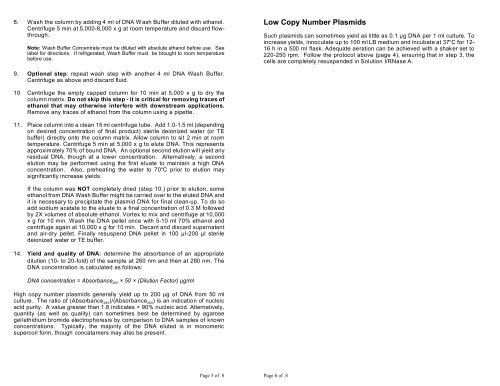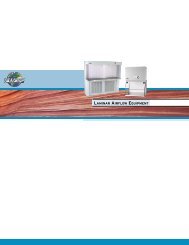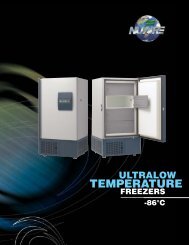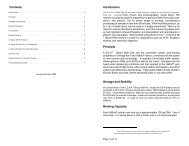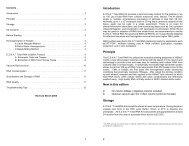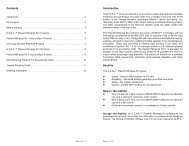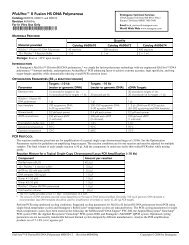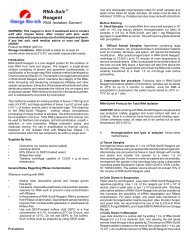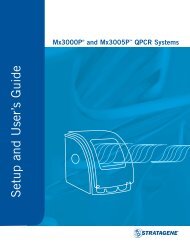E.Z.N.A. ® plasmid midiprep kit Protocol (PDF Version)
E.Z.N.A. ® plasmid midiprep kit Protocol (PDF Version)
E.Z.N.A. ® plasmid midiprep kit Protocol (PDF Version)
You also want an ePaper? Increase the reach of your titles
YUMPU automatically turns print PDFs into web optimized ePapers that Google loves.
8. Wash the column by adding 4 ml of DNA W ash Buffer diluted with ethanol.<br />
Centrifuge 5 min at 5,000-8,000 x g at room temperature and discard flowthrough.<br />
Note: Wash Buffer Concentrate must be diluted with absolute ethanol before use. See<br />
label for directions. If refrigerated, Wash Buffer must be brought to room temperature<br />
before use.<br />
Low Copy Number Plasmids<br />
Such <strong>plasmid</strong>s can sometimes yield as little as 0.1 g DNA per 1 ml culture. To<br />
increase yields, innoculate up to 100 ml LB medium and incubate at 37 o C for 12-<br />
16 h in a 500 ml flask. Adequate aeration can be achieved with a shaker set to<br />
220-250 rpm. Follow the protocol above (page 4), ensuring that in step 3, the<br />
cells are completely resuspended in Solution I/RNase A.<br />
9. Optional step: repeat wash step with another 4 ml DNA Wash Buffer.<br />
Centrifuge as above and discard fluid.<br />
10 Centrifuge the empty capped column for 10 min at 5,000 x g to dry the<br />
column matrix. Do not skip this step - it is critical for removing traces of<br />
ethanol that may otherwise interfere with downstream applications.<br />
Remove any traces of ethanol from the column using a pipette.<br />
11. Place column into a clean 15 ml centrifuge tube. Add 1.0-1.5 ml (depending<br />
on desired concentration of final product) sterile deionized water (or TE<br />
buffer) directly onto the column matrix. Allow column to sit 2 min at room<br />
temperature. Centrifuge 5 min at 5,000 x g to elute DNA. This represents<br />
approximately 70% of bound DNA. An optional second elution will yield any<br />
residual DNA, though at a lower concentration. Alternatively, a second<br />
elution may be performed using the first eluate to maintain a high DNA<br />
concentration. Also, preheating the water to 70 o C prior to elution may<br />
significantly increase yields.<br />
If the column was NOT completely dried (step 10.) prior to elution, some<br />
ethanol from DNA Wash Buffer might be carried over to the eluted DNA and<br />
it is necessary to precipitate the <strong>plasmid</strong> DNA for final clean-up. To do so<br />
add sodium acetate to the eluate to a final concentration of 0.3 M followed<br />
by 2X volumes of absolute ethanol. Vortex to mix and centrifuge at 10,000<br />
x g for 10 min. Wash the DNA pellet once with 5-10 ml 70% ethanol and<br />
centrifuge again at 10,000 x g for 10 min. Decant and discard supernatant<br />
and air-dry pellet. Finally resuspend DNA pellet in 100 l-200 l sterile<br />
deionized water or TE buffer.<br />
14. Yield and quality of DNA: determine the absorbance of an appropriate<br />
dilution (10- to 20-fold) of the sample at 260 nm and then at 280 nm. The<br />
DNA concentration is calculated as follows:<br />
DNA concentration = Absorbance 260<br />
× 50 × (Dilution Factor) g/ml<br />
High copy number <strong>plasmid</strong>s generally yield up to 200 g of DNA from 50 ml<br />
culture. The ratio of (Absorbance 260<br />
)/(Absorbance 280<br />
) is an indication of nucleic<br />
acid purity. A value greater than 1.8 indicates > 90% nucleic acid. Alternatively,<br />
quantity (as well as quality) can sometimes best be determined by agarose<br />
gel/ethidium bromide electrophoresis by comparison to DNA samples of known<br />
concentrations. Typically, the majority of the DNA eluted is in monomeric<br />
supercoil form, though concatamers may also be present.<br />
Page 5 of 8<br />
Page 6 of 8


